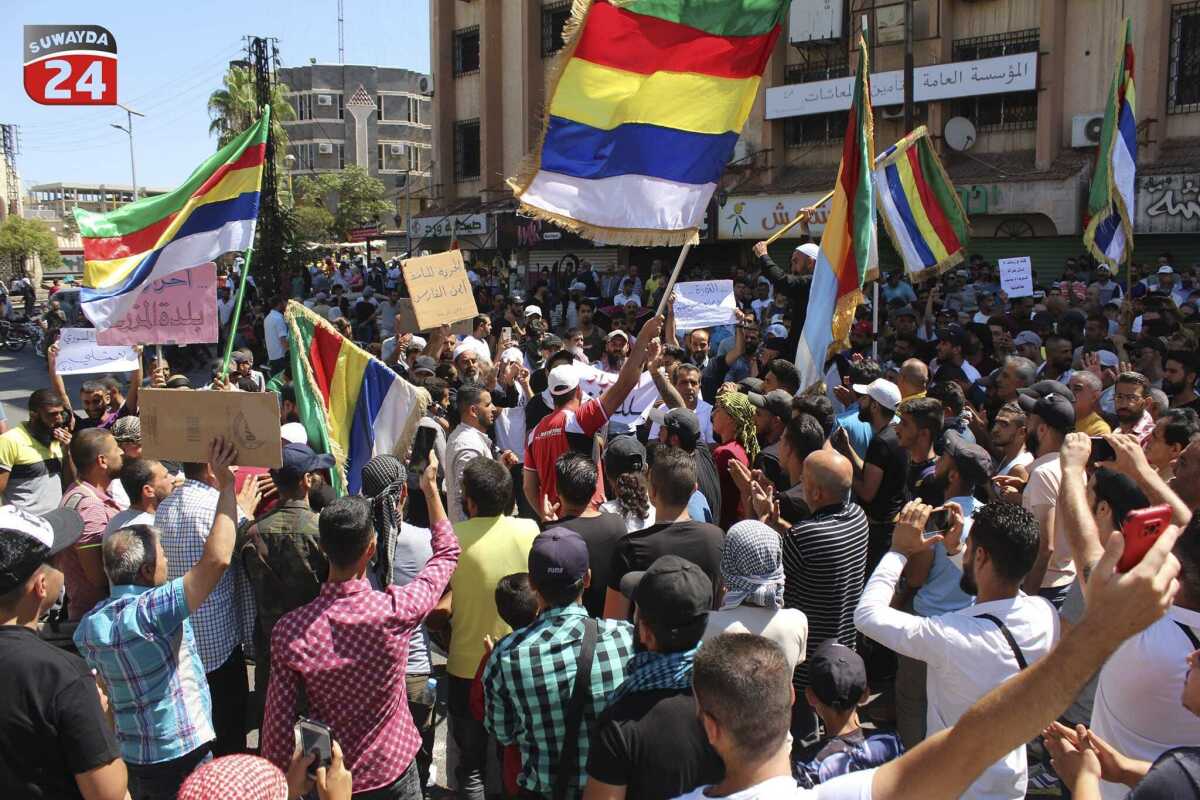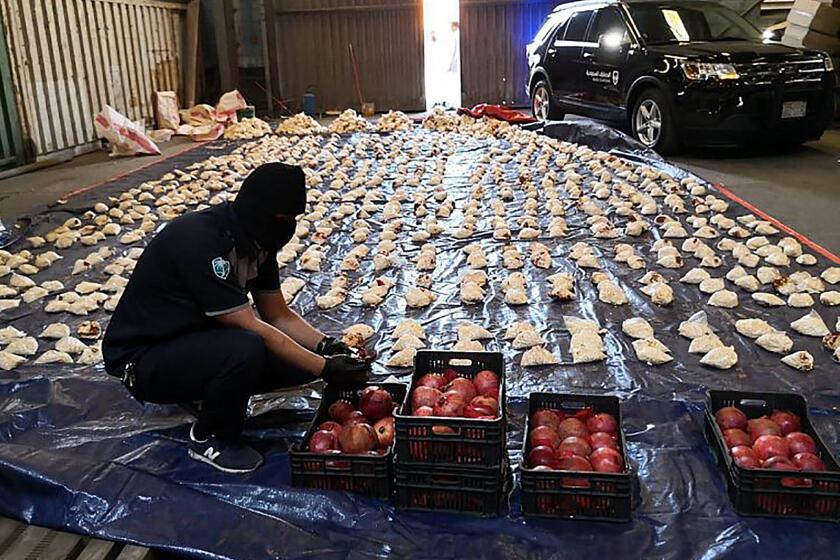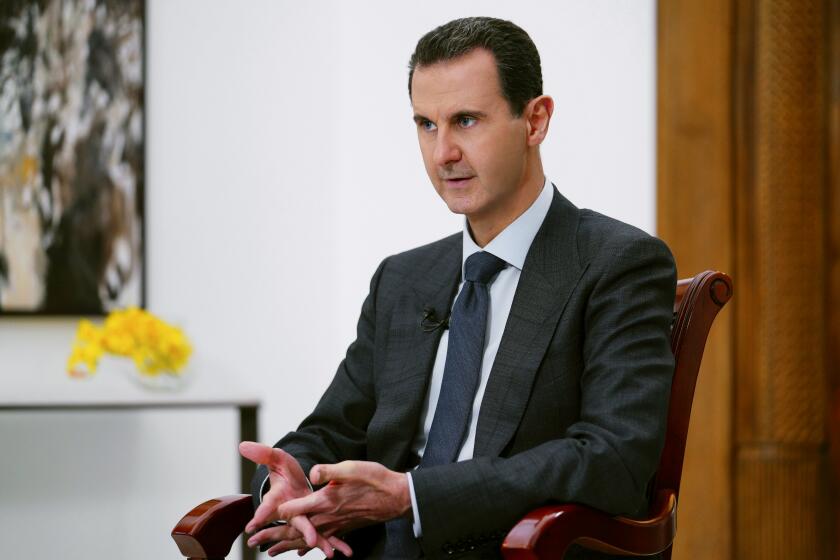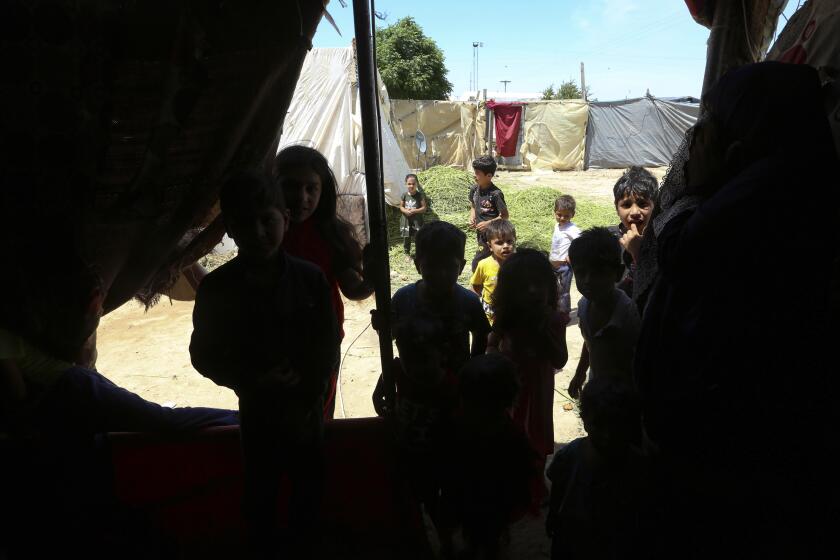Anti-government protests break out in Syria amid heightened economic misery

- Share via
BEIRUT — Anti-government protests in southern Syria have stretched into a second week, with demonstrators waving the colorful flag of the minority Druze community, burning banners of President Bashar Assad’s government and at one point raiding several offices of his ruling party.
The protests were initially driven by surging inflation and the war-torn country’s spiraling economy but quickly shifted focus, with marchers calling for the fall of the Assad government.
The demonstrations have been centered in the government-controlled province of Sweida, the heartland of Syria’s Druze community, which had largely stayed on the sidelines during the long-running conflict between Assad and those trying to topple him.
In a scene that once would have been unthinkable in the Druze stronghold, protesters kicked members of Assad’s Baath party out of some of their offices, welded the doors shut and spray-painted anti-government slogans on the walls.
The protests have rattled the Assad government but don’t seem to pose an existential threat. They come at a time when government forces have consolidated control over most of the country. Meanwhile, Damascus has returned to the Arab fold and restored ties with most governments in the region.
Still, anger is building, even among Syrians who were not part of widespread anti-Assad protests in 2011. Those demonstrations were met with a harsh crackdown and plunged the country into years of civil war.
Western governments have been frustrated by the red carpet treatment Arab countries have been giving Syria’s president.
For some, the final straw came two weeks ago when the Syrian president further scaled back the country’s expensive fuel and gasoline subsidy program. Assad also doubled meager public sector wages and pensions, but those actions did little to cushion the blow, instead accelerating inflation and further weakening the already sinking Syrian pound. The results further piled on the economic pressure on millions living in poverty.
Soon after, protests kicked off in Sweida and the neighboring province of Daraa.
Over the last decade, Sweida had largely isolated itself from Syria’s uprising-turned-conflict. The province witnessed sporadic protests decrying corruption and the country’s economic backslide. This time, crowds quickly swelled into the hundreds, calling out political repression by Assad’s government and stirring echoes of the protests that rocked the country in 2011.
“People have reached a point where they can no longer withstand the situation,” Rayan Maarouf, editor in chief of the local activist media collective Suwayda24, told the Associated Press. “Everything is crumbling.”
An Israeli airstrike has hit the international airport in the city of Aleppo in northern Syria, damaging a runway and putting it out of service.
While Assad’s political fortunes have been on the rise in recent months, life for much of the country’s population has become increasingly miserable. At least 300,000 civilians have been killed in the conflict, half of Syria’s prewar population of 23 million has been displaced and large parts of its infrastructure have been crippled. Ninety percent of Syrians live in poverty. Rampant corruption and Western-led sanctions have also worsened poverty and inflation.
In Daraa — often referred to as the birthplace of the 2011 uprising but now under government control — at least 57 people were arrested in the current protests, according to the Britain-based Syrian Network for Human Rights. Unlike in 2011, government forces did not use lethal force.
In Sweida, the response has been more restrained, with Assad apparently wary of exerting too much force against the Druze. During the years of civil war, his government presented itself as a defender of religious minorities against Islamist extremism.
Over the years, the province’s young men also have armed themselves to defend their villages from Islamic State militants and Damascus-associated militias that produce and trade in illegal amphetamine pills, known as Captagon.
As Middle East countries begin to restore relations with Syrian President Bashar Assad, many Syrian refugees who fled civil war fear they will be forced to return to their homeland.
Joseph Daher, a Swiss-Syrian researcher and professor at the European University Institute in Florence, Italy, believes that this provides a layer of protection for protesters.
“Unlike other government-held areas, Sweida has some form of limited autonomy,” Daher said.
Meanwhile, in Damascus, Lattakia, Tartous and other urban government strongholds, some are voicing their discontent more quietly. They write messages of support for the protests on paper, take pictures of those notes on the streets of their towns and share them on social media.
Others suffer in silence and focus on daily survival. In Damascus, some have taken to carrying backpacks instead of wallets to carry the wads of cash they need to make everyday purchases amid the rampant inflation, while families struggle to buy basic necessities.
Amid the rubble fields of eastern Aleppo, Ibrahim Shabelle was hawking a traditional licorice drink to shoppers, tradesmen and others frequenting a shattered but lively main drag.
“If I buy [my son] two containers of milk, I’d have spent my entire month’s salary,” Damascus resident Ghaswan Wadi told the AP while preparing her family dinner at home after a long day at work.
The ongoing protests highlight Assad’s vulnerability as a result of the failing economy, even in areas that tried to endure the situation and not hold large-scale protests against his rule.
Daher said the protests could eventually threaten Assad’s rule only if the demonstrators banded together.
“You have forms of solidarity from other cities” with Sweida, Daher said. “But you can’t say it would have a real effect on the regime, unless there would be collaboration between [protesters in] different cities.”
More to Read
Sign up for Essential California
The most important California stories and recommendations in your inbox every morning.
You may occasionally receive promotional content from the Los Angeles Times.













